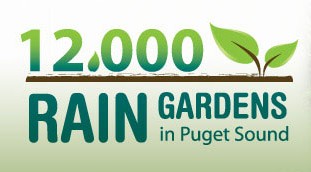 Everyone knows it rains a lot in Seattle and with the Puget Sound on our doorstep, stormwater runoff can have a huge impact on the aquatic ecosystem. In the Puget Sound there are octopus, sharks, harbor seals, sea anemones, sea stars, crabs, clams, salmon and something called sea cauliflower. This multitude of wildlife is important culturally, economically as well as environmentally. Stormwater runoff is the rainwater that falls and runs over impervious surfaces to the nearest waterways. In places without impervious surfaces, the water is intercepted by trees, plants and the leaf litter on the ground and moves extremely slowly over the ground, permitting time to infiltrate into the water table and aquifers. There are several problems with impervious surfaces, the first being a dramatic speeding up of the movement of water. Impervious surfaces such as streets, sidewalks, parking lots, roofs and other paved areas often result in flooding problems, excessive erosion and increased sediment in waterways by altering the natural hydrologic cycle. Water running over all surfaces picks up pollutants from car oils and heavy metals on roads and pesticides on lawns. As a result, 14 million pounds of toxin enter the Puget Sound every single year.
Everyone knows it rains a lot in Seattle and with the Puget Sound on our doorstep, stormwater runoff can have a huge impact on the aquatic ecosystem. In the Puget Sound there are octopus, sharks, harbor seals, sea anemones, sea stars, crabs, clams, salmon and something called sea cauliflower. This multitude of wildlife is important culturally, economically as well as environmentally. Stormwater runoff is the rainwater that falls and runs over impervious surfaces to the nearest waterways. In places without impervious surfaces, the water is intercepted by trees, plants and the leaf litter on the ground and moves extremely slowly over the ground, permitting time to infiltrate into the water table and aquifers. There are several problems with impervious surfaces, the first being a dramatic speeding up of the movement of water. Impervious surfaces such as streets, sidewalks, parking lots, roofs and other paved areas often result in flooding problems, excessive erosion and increased sediment in waterways by altering the natural hydrologic cycle. Water running over all surfaces picks up pollutants from car oils and heavy metals on roads and pesticides on lawns. As a result, 14 million pounds of toxin enter the Puget Sound every single year.
To combat this runoff, Stewardship Partners and Washington State University Extension have joined forces with a large group of partners to launch the 12,000 Rain Gardens in Puget Sound Campaign. The goal is to register 12,000 rain gardens in the Puget Sound region before 2016, and they’re already well on their way with 684 gardens registered. Rain gardens are a relatively recent idea but a lot has been done in the Pacific Northwest. The City of Portland has a successful Green Streets program which is now several years old and a number of rain gardens at schools. However, the 12,000 Rain Gardens in Puget Sound may be the most ambitious effort so far. Anybody can participate including homeowners, schools, industry and entire communities.
A rain garden is a landscaped area where stormwater is directed from roofs, streets, other hard surfaces or even softer surfaces like lawns. The rain garden is an area with a low point, sloped sides and an overflow outlet. It’s similar in structure to a very shallow pond, but not meant to retain water for long periods of time. Instead they only hold water until it infiltrates into the ground, or during heavy rain events the water flows out into the overflow outlet. They can be constructed in any shape or size with a wide variety of plants. The planting includes great diversity because each level, such as the wet bottom or the drier slopes, requires different plants. There is a benefit for wildlife also because rain gardens offer excellent habitat for a variety of species. Many insects will be attracted to rain gardens and if larval plants are included, butterflies and moths will lay eggs in the rain garden. Pollinators will visit the many nectar plants, amphibians may visit during the wet season and reptiles during the dry season. Birds will also visit to feed on insects or the berry-producing plants and dragonflies may perch on plants.
It’s very easy to create a rain garden in the Pacific Northwest. There is an instructional guide to creating rain gardens in Western Washington which can be downloaded: Rain Garden Handbook for Western Washington Homeowners (PDF). The guide includes directions for planning, designing, installation and maintenance. In addition it includes cost estimates, resources, sample plans for various situations and a plant list, many of which are also excellent wildlife plants. Additionally, there are numerous rain garden workshops offered around the region There are several incentives around the Puget Sound to help homeowners install their gardens such as the RainWise Program from Seattle Public Utilities and the Rain Garden Cost-Share Program from Kitsap Conservation District.
There has already been great success for the program, the City of Puyallup received the “Going Green” 2011 Municipal Excellence Award from the Association of Washington Cities for their rain gardens. They installed 20 rain gardens in neighborhood groupings in three different neighborhoods.






There are now 10 new rain gardens installed in the West Seattle Delridge community by Stewardship Partners this past July. Enjoy a new Caffe Vita 12,000 Rain Gardens Coffee blend and a portion of sales goes towards installing rain gardens. All this exciting stuff and even an industrial rain garden at the Port of Tacoma that protects Commencement Bay from zinc and other heavy metals. Please visit our website for this and many other rain garden examples.